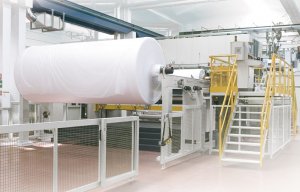
Oerlikon presents partnerships at IDEA 2019
Today, car roofs, body parts and interior components such as claddings, switches and operating elements are being manufactured from industrial textiles.

6th May 2015
Innovation in Textiles
|
Remscheid/Frankfurt
The Oerlikon Manmade Fibers Segment of the Swiss Oerlikon Group, with its two brands – Oerlikon Barmag and Oerlikon Neumag – is offering numerous technologies for manufacturing industrial yarns, fibres and nonwovens at the Techtextil exhibition that is being held in Frankfurt this week.
The global market for industrial textiles is expanding considerably and automotive construction is seen as the number one consumer. According to the information provided by a Commerzbank study carried out in 2014, the global market for industrial textiles (without nonwovens and composites) totalled US 133 billion in 2012 with a production volume of 22 million tons and is set to rise to US 160 billion by 2018.
In Germany alone, around 50 medium-sized textile companies with 10,000 members of staff working as automobile sector suppliers are generating a turnover of more than EUR 4 billion.
Today, car roofs, body parts and interior components such as claddings, switches and operating elements are being manufactured from industrial textiles. And the development laboratories are working on smart materials for the cars of the future.
Oerlikon Barmag, the leader in the manufacture of spinning and texturing systems for manmade fibres, offers high-tech solutions for the production of yarns for safety belts.
The fabric construction of a safety belt should not restrain people inside vehicles to avoid injury, whilst reducing or delaying the force exerted on the body during an impact. “The manufacture of the belt yarn therefore has to comply with such challenging requirements as absence of lint, dyeability and perfect package build”, explained Ulrich Enders, Head of Development at Oerlikon Barmag in Remscheid.
These are made possible by machine concepts with up to 8 ends for the efficient production of high-tenacity, lint-free PET yarn with titers of up to 1,500 denier for safety belts. The special SFL (Single Filament Layer) technology is said to guarantee an extremely gentle yarn path with even heating and drawing of the individual filaments using five pairs of heated godets.
“Currently, our customers continue to manufacture most airbag yarns from nylon. As a result of the ever growing diversity of airbag applications and also the ever larger systems – such as side, curtain and meanwhile also pedestrian airbags – the less expensive polyester is being increasingly focused on,” said Stefan Becker.
Against this background, cost-efficient manufacture is quite a challenge for producers, the company believes. Oerlikon Barmag offers the machine using special spin packs that can manufacture up to 12, in specific cases also up to 16, polyester filaments.
Threads used for airbags have particularly fine filaments, as a result of the special fabric construction, and are therefore more sensitive to friction. The design of the system caters to this with a special yarn guide. The spinning machines are said to fulfil high quality standards for airbags, which have to ensure the greatest degree of safety for occupants.
Oerlikon Barmag also produces machines for HMLS (high-modulus low-shrinkage) yarns. These preliminary polyester products are primarily deployed for manufacturing tire cord. They are extremely tear-resistant, while nevertheless remaining highly elastic and stable in terms of their dimensions and temperature, the manufacturer reports.
The EvoQuench HMLS system was developed for manufacturing such challenging HMLS yarns. It deploys so-called radial quenching for the filaments to ensure their extremely even cooling following spinning. This technology is said to enable the manufacture of products with very high numbers of filaments and improve the quality of the individual threads.
Oerlikon Barmag also supplies automobile POY yarn solutions. The proven dynamic mixing principle of the 3DD mixer is said to enable textile yarns to be dyed during the manufacturing process. This spun-dyed POY is further processed into air-textured yarn and used in seat upholstery, roof linings and door claddings.
Here, the 3D, highly-efficient mixing principle is said to permit outstanding dispersive and distributive mixing of, for example, dye concentrates, fillers and additives that are fed into the polymer melt. Even small amounts and additives with vastly differing viscosities with a ratio of 1:100 can be homogeneously mixed and distributed.

Business intelligence for the fibre, textiles and apparel industries: technologies, innovations, markets, investments, trade policy, sourcing, strategy...
Find out more